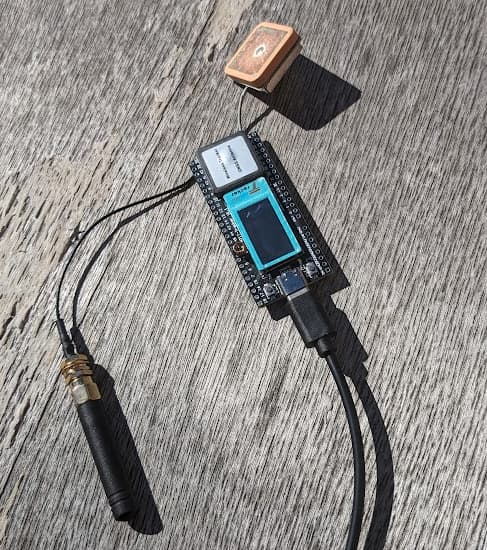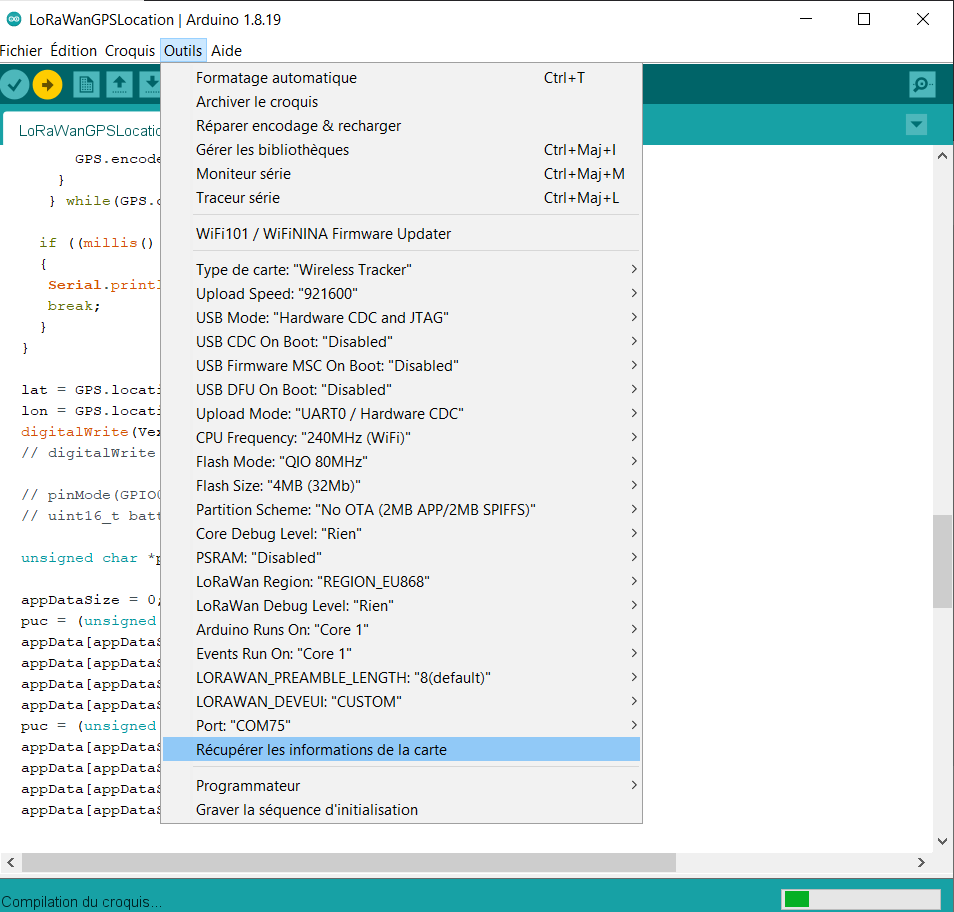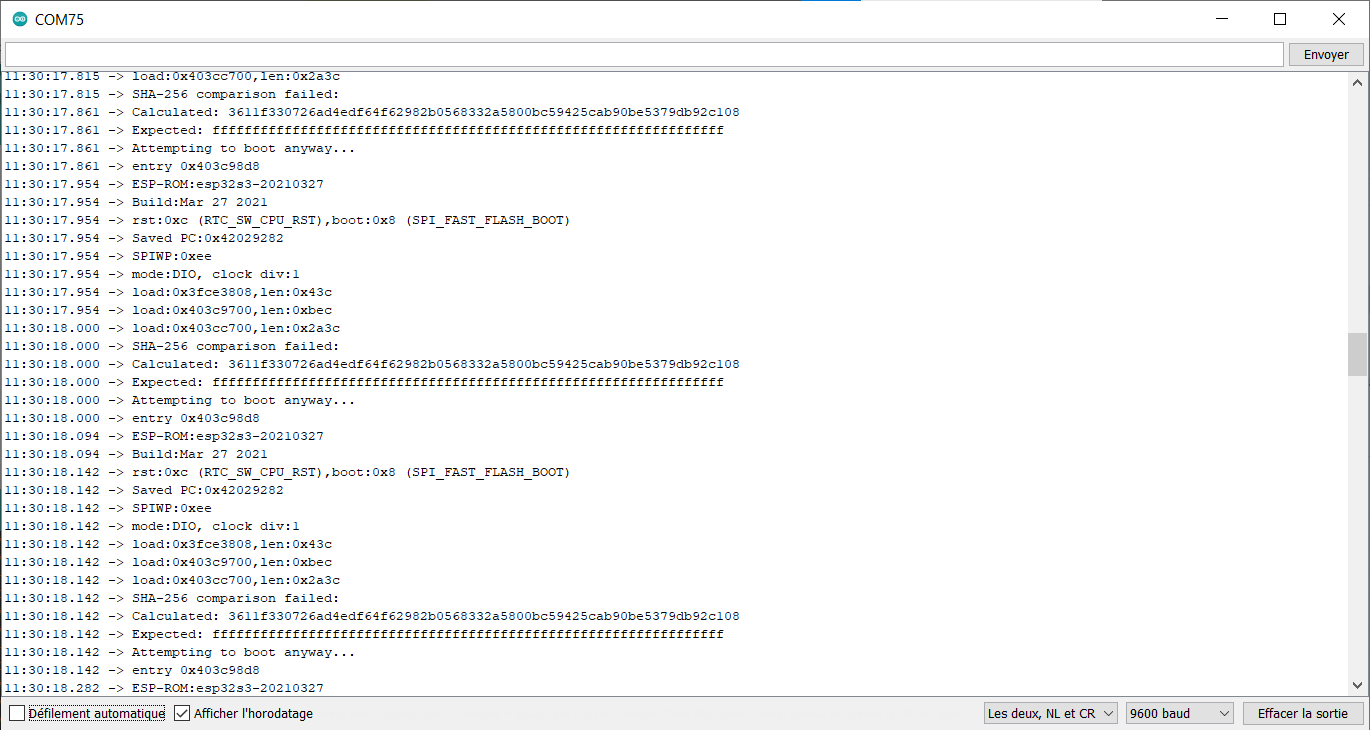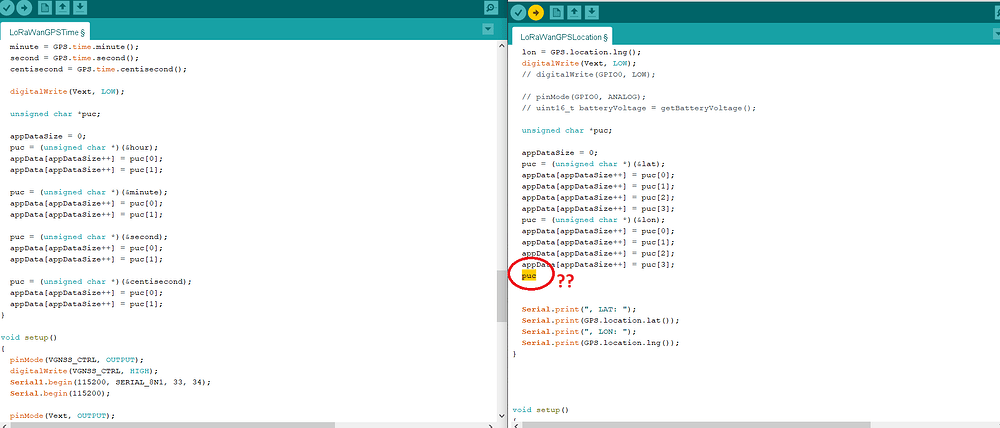Hi everyone,
I just received my HTIT-Tracker from Heltec, v1.1. My goal is to map my LoRa network range with RSSI and GPS location sent every 5min by TTN.

After downloading the board here and put these configurations :

I flash the GPSTime Code just to see the time, (outside of course).
/* Heltec Automation LoRaWAN communication example
*
* Function:
* 1. Read the time of GPS and upload it to the LoRaWAN server.
* 2. Display the time of GPS on the screen.
*
* Description:
* 1. Communicate using LoRaWAN protocol.
*
* HelTec AutoMation, Chengdu, China
* 成都惠利特自动化科技有限公司
* www.heltec.org
*
* this project also realess in GitHub:
* https://github.com/Heltec-Aaron-Lee/WiFi_Kit_series
* */
#include "LoRaWan_APP.h"
#include "Arduino.h"
#include "HT_st7735.h"
#include "HT_TinyGPS++.h"
TinyGPSPlus GPS;
HT_st7735 st7735;
#define VGNSS_CTRL 3
/* OTAA para*/
uint8_t devEui[] = {0xXX, 0xXX, 0xXX, 0xXX, 0xXX, 0xXX, 0xXX, 0xXX};
uint8_t appEui[] = {0x00, 0x00, 0x00, 0x00, 0x00, 0x00, 0x00, 0xXX};
uint8_t appKey[] = {0xXX, 0xXX,0xXX, 0xXX,0xXX, 0xXX,0xXX, 0xXX, 0xB1, 0x6A, 0x5D, 0xDF, 0xC2, 0x56, 0xEA, 0x6B};
/* ABP para*/
uint8_t nwkSKey[] = {0x15, 0xb1, 0xd0, 0xef, 0xa4, 0x63, 0xdf, 0xbe, 0x3d, 0x11, 0x18, 0x1e, 0x1e, 0xc7, 0xda, 0x85};
uint8_t appSKey[] = {0xd7, 0x2c, 0x78, 0x75, 0x8c, 0xdc, 0xca, 0xbf, 0x55, 0xee, 0x4a, 0x77, 0x8d, 0x16, 0xef, 0x67};
uint32_t devAddr = (uint32_t)0x007e6ae1;
/*LoraWan channelsmask, default channels 0-7*/
uint16_t userChannelsMask[6] = {0x00FF, 0x0000, 0x0000, 0x0000, 0x0000, 0x0000};
uint32_t license[4] = {0x21701168, 0xAAAEEC0A, 0xFDA9F9D2, 0x0110E29E};
/*LoraWan region, select in arduino IDE tools*/
LoRaMacRegion_t loraWanRegion = ACTIVE_REGION;
/*LoraWan Class, Class A and Class C are supported*/
DeviceClass_t loraWanClass = CLASS_A;
/*the application data transmission duty cycle. value in [ms].*/
uint32_t appTxDutyCycle = 15000;
/*OTAA or ABP*/
bool overTheAirActivation = true;
/*ADR enable*/
bool loraWanAdr = true;
/* Indicates if the node is sending confirmed or unconfirmed messages */
bool isTxConfirmed = true;
/* Application port */
uint8_t appPort = 2;
/*!
Number of trials to transmit the frame, if the LoRaMAC layer did not
receive an acknowledgment. The MAC performs a datarate adaptation,
according to the LoRaWAN Specification V1.0.2, chapter 18.4, according
to the following table:
Transmission nb | Data Rate
----------------|-----------
1 (first) | DR
2 | DR
3 | max(DR-1,0)
4 | max(DR-1,0)
5 | max(DR-2,0)
6 | max(DR-2,0)
7 | max(DR-3,0)
8 | max(DR-3,0)
Note, that if NbTrials is set to 1 or 2, the MAC will not decrease
the datarate, in case the LoRaMAC layer did not receive an acknowledgment
*/
uint8_t confirmedNbTrials = 4;
void GPS_test(void)
{
Serial.println("GPS_test");
st7735.st7735_fill_screen(ST7735_BLACK);
delay(100);
st7735.st7735_write_str(0, 0, (String) "GPS_test");
if (Serial1.available() > 0)
{
if (Serial1.peek() != '\n')
{
GPS.encode(Serial1.read());
}
else
{
Serial1.read();
}
}
}
/* Prepares the payload of the frame */
static void prepareTxFrame(uint8_t port)
{
/*appData size is LORAWAN_APP_DATA_MAX_SIZE which is defined in "commissioning.h".
appDataSize max value is LORAWAN_APP_DATA_MAX_SIZE.
if enabled AT, don't modify LORAWAN_APP_DATA_MAX_SIZE, it may cause system hanging or failure.
if disabled AT, LORAWAN_APP_DATA_MAX_SIZE can be modified, the max value is reference to lorawan region and SF.
for example, if use REGION_CN470,
the max value for different DR can be found in MaxPayloadOfDatarateCN470 refer to DataratesCN470 and BandwidthsCN470 in "RegionCN470.h".
*/
pinMode(Vext, OUTPUT);
digitalWrite(Vext, HIGH);
uint8_t hour, second, minute, centisecond;
Serial.println("Waiting for GPS time FIX ...");
while (!GPS.location.isValid())
{
// smartDelay(1000);
uint32_t start = millis();
do
{
if (Serial1.available())
{
GPS.encode(Serial1.read());
}
} while (GPS.charsProcessed() < 100);
; //(GPS.charsProcessed() < 10); //
if ((millis() + start) > 10000) // && GPS.charsProceSerial1ed() < 10)
{
Serial.println("No GPS data received: check wiring");
break;
}
}
Serial.printf(" %02d:%02d:%02d.%02d", GPS.time.hour(), GPS.time.minute(), GPS.time.second(), GPS.time.centisecond());
String time_str = (String)GPS.time.hour() + ":" + (String)GPS.time.minute() + ":" + (String)GPS.time.second() + ":" + (String)GPS.time.centisecond();
st7735.st7735_write_str(0, 0, time_str);
delay(1000);
hour = GPS.time.hour();
minute = GPS.time.minute();
second = GPS.time.second();
centisecond = GPS.time.centisecond();
digitalWrite(Vext, LOW);
unsigned char *puc;
appDataSize = 0;
puc = (unsigned char *)(&hour);
appData[appDataSize++] = puc[0];
appData[appDataSize++] = puc[1];
puc = (unsigned char *)(&minute);
appData[appDataSize++] = puc[0];
appData[appDataSize++] = puc[1];
puc = (unsigned char *)(&second);
appData[appDataSize++] = puc[0];
appData[appDataSize++] = puc[1];
puc = (unsigned char *)(¢isecond);
appData[appDataSize++] = puc[0];
appData[appDataSize++] = puc[1];
}
void setup()
{
pinMode(VGNSS_CTRL, OUTPUT);
digitalWrite(VGNSS_CTRL, HIGH);
Serial1.begin(115200, SERIAL_8N1, 33, 34);
Serial.begin(115200);
pinMode(Vext, OUTPUT);
digitalWrite(Vext, HIGH);
Mcu.setlicense(license);
st7735.st7735_init();
st7735.st7735_fill_screen(ST7735_BLACK);
Mcu.begin();
deviceState = DEVICE_STATE_INIT;
}
void loop()
{
switch (deviceState)
{
case DEVICE_STATE_INIT:
{
#if (LORAWAN_DEVEUI_AUTO)
LoRaWAN.generateDeveuiByChipID();
#endif
LoRaWAN.init(loraWanClass, loraWanRegion);
break;
}
case DEVICE_STATE_JOIN:
{
LoRaWAN.join();
st7735.st7735_write_str(0, 0, "join>>>");
break;
}
case DEVICE_STATE_SEND:
{
prepareTxFrame(appPort);
LoRaWAN.send();
deviceState = DEVICE_STATE_CYCLE;
break;
}
case DEVICE_STATE_CYCLE:
{
txDutyCycleTime = appTxDutyCycle + randr(-APP_TX_DUTYCYCLE_RND, APP_TX_DUTYCYCLE_RND);
LoRaWAN.cycle(txDutyCycleTime);
deviceState = DEVICE_STATE_SLEEP;
break;
}
case DEVICE_STATE_SLEEP:
{
LoRaWAN.sleep(loraWanClass);
break;
}
default:
{
deviceState = DEVICE_STATE_INIT;
break;
}
}
}
Here is a result.
Is there some configuration I am missing ?

